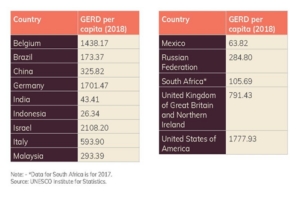
Home » India’s R&D Ecosystem – Current Status

Research and development (R&D) is essential for boosting corporate competitiveness, creating sustainable solutions, increasing economic growth, and enhancing efficiency. The expansion and prosperity of companies and sectors around the world depend on this. Any nation must drastically alter its ecosystem for research, innovation, and R&D if it wants to expand and maintain its growth.
India has to invest in and support the scientific and technology (S&T), innovation, and R&D environment in order to continue propelling its growth narrative over the coming decades. It also needs to adapt to the quickly advancing technologies.
Prior to commencing the discourse, it is imperative to grasp the fundamental statistics and parameters that delineate research and development ecosystems.

Patent Reform is Necessary for Innovation
Industry leaders and business magnates in India, kindly advance, surpass the government sector in R&D expenditure, and contribute to the nation’s shining success!
A robust research and development ecosystem in India has the potential to generate substantial economic expansion and societal advantages, in addition to tackling some of the most critical global issues. India possesses an exceptionally fertile environment for fostering its own research and development ecosystem. This will not only assist the nation in achieving its aspirational status as a global leader in R&D, innovation, technology, and manufacturing, but it will also contribute to the expansion of the global economy and the welfare of its citizens.
Dr. Swapnila Roy
Associate Dean(R&D)
Department of Research and Development
Lingaya’s Vidyapeeth
RECENT POSTS
CATEGORIES
TAGS
Agriculture Agriculture future AI Architecture artificial intelligence Bachelor of Commerce BA English BA Psychology BTech AIML BTech CSE BTech Engineering Business management career Career-Specific Education career guide career option career scope Civil engineering commerce and management Computer Science Computer science engineering Data science degree education Engineering Engineering students English Literature english program Fashion Design Fashion design course Higher Education Journalism journalism and mass communication law Law career Machine Learning Master degree mathematics MBA MBA specialization Mechanical Engineering Pharmacy Psychology Research and Development students
University Address: Nachauli, Jasana Road, Faridabad, Haryana
For Admissions :
Toll Free: 1800-120-4613
Mobile : 8447744303 | 8447744304 | 8447744306 | 8447744309
8700003974 | 8700003411 | 8700003749
Address: C-72, Second Floor, Shivalik, Near Malviya Nagar,
Above HDFC Bank, New Delhi 110017
Landline No. - 011-46570515 / 45138169 / 41755703
Mobile No. - +91-7303152412 / +91-7303152420 / +91-9311321952
Jagmani Kutir, Ground Floor, Road No-1, Rajeev Nagar,
Near Darbar Marriage Hall, Patna-800024, Bihar
Contact No: 9818352069/ 8130120095
Mail: kanhaiya@lingayasvidyapeeth.edu.in
Copyrights © 1998 - 2025 Lingaya's Vidyapeeth (Deemed To Be University). All rights reserved.
It is important to note that the following email IDs and domains are fraudulent and do not belong to our university.
LV only conducts physical/online verification of any document related to examination on the following email id: